Two days after Christmas 1972, the sky over Guam was black with B-52s returning from a massive raid on North Vietnam. One by one from the west came 78 of them, a minute or so apart, landing lights blazing, engines whining as they let down over the lagoon and then turned left to touch down at Andersen Air Force Base, from which they had launched 18 hours earlier.
Before, the BUFFs had been bombing South Vietnam in milk runs, usually in cells of three that laid down carpets of devastation 3,000 feet wide and 9,000 feet long. They rarely ran into opposition and their main enemy was boredom.
When the B-52s shifted to targets in North Vietnam for Operation Linebacker II, they used the same formations but flew into perhaps the thickest air defense assembled since World War II. Unlike in World War II, however, these air defenses were composed mostly of surface-to-air missiles. The US suffered heavy losses of crews and bombers.
 |
(Staff illustration by Zaur Eylanbekov) |
During a stand-down on Christmas Day, Strategic Air Command and 8th Air Force decided to return to a principle of war: mass. A raid of 120 B-52s, 78 from Andersen and 42 from U Tapao AB, Thailand, was mounted during the night of Dec. 26. They overwhelmed North Vietnam’s defenses by striking 10 targets, with all bombing runs completed within 15 minutes.
It was the largest launch of B-52s in history. Having accomplished their mission with only two bombers lost—both from U Tapao—they returned to Andersen.
Today, Guam is being revived as a pivot point in a sweeping realignment of US forces in the Pacific and Asia. The island will be a centerpiece in the American response to 21st century national security threats—notably a potential adversary in China.
Until now, the deployment of air, naval, and ground forces to the island reflected decisions made from World War II through the Cold War. Command lines, in particular, had become encrusted and needed to be streamlined. So, too, did the deployment of forces. Simply put, after Vietnam, Andersen and Guam fell into a lull that some called a “sleepy hollow.”
Three times in subsequent years, however, the air base provided a haven. First it was for Vietnamese refugees, then for Americans fleeing from the Philippines after a volcanic eruption, and finally for Kurds from northern Iraq in 1996. Over those years, the island absorbed numerous typhoons and an earthquake.
Conceptual backing for Guam’s strategic rebirth has come from several military thinkers. Retired Army Gen. Barry R. McCaffrey recently wrote that the looming challenge to the US in the Pacific and Asia is “the legitimate and certain emergence of the People’s Republic of China [PRC] as a global economic and political power.”
McCaffrey said that China was acquiring “the military muscle to challenge and neutralize the deterrence capacity of the US Navy and Air Force in the broad reaches of the Pacific maritime frontier.” In addition, he wrote, “by 2020 we will face resurgent and expanding Russian Federation military power projection capacity as well as the likely emergence of other major maritime and air nuclear powers.”
A Frontline Base
Guam has thus once again been thrust into the front lines of the US security posture.
Missions from the island are evolving into four: Deterrence, warfighting, supporting anti-terrorist and anti-piracy operations, and humanitarian assistance.
Deterrence is aimed at China, with its swiftly expanding military power; at North Korea, which has long threatened to assault South Korea; and at Russia, which has been reasserting itself with unknown consequences.
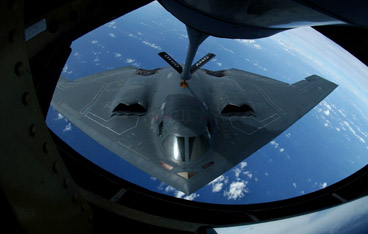 |
A B-2 Spirit deployed to Andersen AFB, Guam, refuels over the Pacific Ocean. (USAF photo by SrA. Brian Kimball) |
If deterrence fails and hostilities break out, Guam will become a front-line base. “We will fight from here,” said Air Force Col. Joel S. Westa, vice commander of the 36th Wing at Andersen. The island’s benefits are clear: It is sovereign US territory, it is central to numerous possible flash points, it provides strategic depth, and it has space available for a military buildup.
Not so incidentally, Guam is also situated along what the Chinese call the “second island chain” to which the communist military intends to project air and sea power in the foreseeable future. That island chain is anchored in central Japan, passes through Guam, and extends into the South Pacific. (The first island chain passes from southern Japan through Taiwan into the South China Sea.)
A buildup of forces from all four military services on Guam over the next 10 years has the potential to cause a clash of cultures on the crowded island, however.
“The services have different cultures and approaches to doing business,” said Air Force Lt. Gen. Daniel P. Leaf, the deputy commander of US Pacific Command, who has been charged with overseeing the Guam buildup. “Those differences can cause a clash that is counterproductive, but we’re committed to building a compatible construct for co-located units.”
Accommodating this expansion of forces will require extensive construction, both on the existing bases and the civilian side of Guam. A master plan is under discussion within the military community there and between the military staff and the government of Guam. It is due to be completed in the spring of 2008 and to cover a period of 10 years.
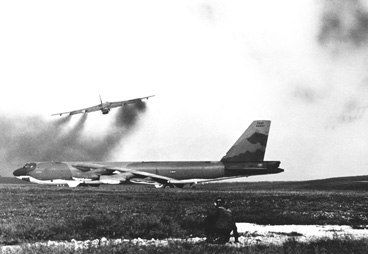 |
A B-52D leaves a heavy smoke trail behind as it takes off for a mission over North Vietnam during Operation Linebacker in 1972. Another one waits its turn. |
A critical element will be protection from typhoons as Guam sits in a typhoon alley. Air Force officers said they would need 48 small, hardened hangars to house fighters against the weather. A large hangar for the Global Hawks and other large aircraft is under construction at a cost of $40 million. It is designed to withstand typhoon winds up to 170 mph and will be earthquake resistant. Bombers and tankers will not have new hangars but will necessarily be flushed to Kadena Air Base in Japan or to Hickam Air Force Base in Honolulu before a typhoon strikes.
Officers said initially they planned hangars for deploying B-2s because their stealth characteristic required that they be housed when not flying. That requirement has gone away because new technology made that protection unnecessary.
Some of Andersen’s runways, known for the dip in the middle that makes a bomber almost disappear from sight before it climbs out and takes off, have been reinforced and others will be improved later.
The runways on the auxiliary Northwest Field, adjacent to the main base, still need to be resurfaced. PACOM has directed that Northwest Field be preserved with nothing built on it.
Facilities to support the Navy’s incoming fast-attack and cruise missile submarines are mostly in place, but the Apra Harbor must be dredged and maintenance shops built to service nuclear-powered aircraft carriers.
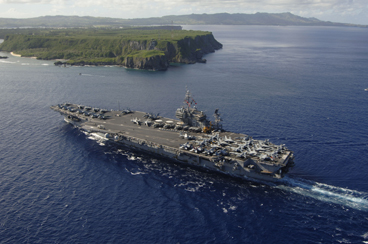 |
USS Kitty Hawk arrives in Guam in June 2007. (USN photo by Mass Comm. Spec. Seaman Stephen Rowe) |
It is the Marines Corps, thinking of 50 to 70 years on Guam, that will need to do the most work to accommodate a coming influx of 17,000 people. The bill for buildings, hangars, embarkation points, repair shops, housing, and moving costs is estimated to come to $10 billion, of which the Japanese government has pledged to pay 60 percent.
Marine Corps survey teams have identified several sites they could use. An area known as Andersen South has an old and not well-maintained housing area that could be used for training in house-to-house fighting. Two sites in the waist of the island could be used for maneuvers. Similarly, an old Navy ammunition storage area in the south might be used for small-arms training.
The Air Force already maintains what it calls a “persistent presence” of bombers at Andersen. Normally, a squadron of B-52s, B-1s, or B-2s is on the island on a four-month rotation. That presence may increase if the Navy’s aircraft carriers are away in the Indian Ocean or elsewhere, with bombers being called on to backfill.
Four stealthy B-2 bombers from the 509th Bomb Wing at Whiteman AFB, Mo., deployed to Andersen in October, for example, to replace six B-52s from the 2nd Bomb Wing at Barksdale AFB, La.
Fighters will also often be at Andersen, again on four-month rotations, but not necessarily with the continual presence shown by the bombers. Eighteen F-16 fighters from the 27th Fighter Wing, Cannon AFB, N.M., were at Andersen in mid-2007, but were not immediately replaced.
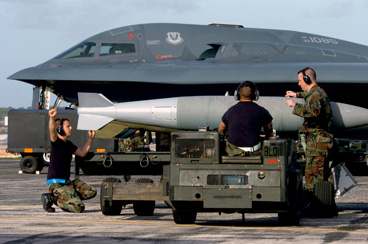 |
Weapons specialists (l-r) A1C Tommy Day, SrA. Phillip Ruiz, and TSgt. Dwayne Bolles prepare to load a BDU-56 bomb on a B-2 at Andersen. (USAF photo by MSgt. Val Gempis) |
In later years, the fighters deployed to Andersen will include the new F-22 Raptor. Three of the Air Force’s seven F-22 squadrons are to be assigned to Pacific Air Forces, with two to be based in Alaska and one in Hawaii. One Raptor squadron has already done a familiarization tour on Guam and at Kadena.
The Raptor performs both air-to-air and air-to-ground missions and is designed to penetrate thick air defenses such as that the Chinese are constructing.
Further, the Air Force will station three Global Hawk unmanned surveillance aircraft at Andersen, with the first due to arrive in mid-2009; a fourth is possible later.
These high-flying, long-endurance drones will give commanders near-real-time intelligence. During a typical Global Hawk mission, the aircraft can fly more than 1,300 miles at 65,000 feet and remain on station for 24 hours. Shanghai, on the coast of China, is 1,900 miles from Guam, while Seoul, the South Korean capital, is 2,000 miles distant.
A Tanker Presence
Besides its conventional combat missions, PACOM officials said Global Hawk could target terrorist training camps in Southeast Asia or pirates in the South China Sea. From Guam to Singapore is 2,900 miles. The intelligence UAVs could also support humanitarian missions such as the disaster relief operation mounted after the destructive tsunami in the Indian Ocean in 2004.
Tankers have also begun rotations to Andersen. Earlier this year, an expeditionary squadron from MacDill Air Force Base in Tampa, Fla., and Grand Forks AFB, N.D., did a 120-day rotation on Guam. Air National Guard tankers will also come.
 |
B-52s deployed from Barksdale AFB, La., take off from Andersen in support of the 7th Air Expeditionary Wing’s mission. (DOD photo) |
Bomber and fighter squadrons will bring tankers with them, but several will need to be stationed at Andersen to support permanent missions. “We are tanker dependent,” says Lt. Gen. Loyd S. Utterback, who commands 13th Air Force at Hickam. “We need [tankers] to get there and to stay there,” he said, noting that tanker recapitalization is the No. 1 modernization priority for the Air Force.
The Navy’s role in the military expansion on Guam centers on attack submarines already deployed to the island; on a way station for two newly converted submarines armed with cruise missiles; and on a new berth for an aircraft carrier. This carrier berth will mean a flattop need not return to Hawaii or the West Coast for routine maintenance or resupply.
The three fast-attack submarines (fast-attack being one word in submarine lingo) are supported by the tender Frank Cable. The advantage of having these boats based in Guam is that it helps to overcome “the tyranny of distance.” In a crisis, a submarine can get to the Taiwan Strait, for instance, in 48 hours as opposed to the six days the trip would take from Pearl Harbor—or the more than eight days from San Diego.
The cruise missile carriers, based in Bangor, Wash., have been converted from ballistic missile submarines, or boomers, and can each be armed with up to 154 cruise missiles. Those missiles can be fired singly or in salvo and at ships or targets on land. The two being assigned to the Pacific Fleet are Michigan and Ohio.
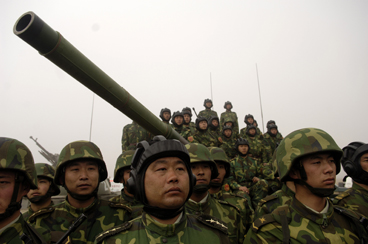 |
Chinese armor forces listen to Marine Corps Gen. Peter Pace, then Chairman of the Joint Chiefs of Staff, after a demonstration at Shenyang training base in China. (DOD photo by SSgt. D. Myles Cullen) |
Each will have a Blue and a Gold crew, like the boomers, so they can stay on patrol for up to 400 days. In the middle of that deployment, they will surface and pull into Guam for 21 days to swap crews, undertake maintenance, and take on fresh supplies. The submarines can also take aboard special operations forces, land them to infiltrate a target area, then return later to pick them up.
For many months, naval officers, political leaders, and a variety of lobbyists for commercial interests argued over where a sixth Pacific Fleet aircraft carrier should be based. Guamanians wanted the carrier there, some in Hawaii wanted it at Pearl Harbor, and others in California sought to have it based on the West Coast.
Permanent Assignments
San Diego won out, largely because the facilities to support a nuclear-powered carrier were in place already. Thus, when Carl Vinson comes out of overhaul in 2010, it will be based in San Diego.
The 97,000 ton carrier, its 85 aircraft, and crew of 5,700, however, will spend a lot of time in the western Pacific, the South China Sea, and the Indian Ocean. By building a berth at Guam, the Navy will be able to keep Carl Vinson and other nuclear-powered carriers based on the West Coast on station much longer than would otherwise be possible. A carrier can also be serviced in Japan, where the nuclear-powered carrier George Washington will replace the conventionally powered Kitty Hawk in 2008.
Other moves to Guam are permanent assignments.
The Army will have the smallest and as yet undetermined element in the new Guam. It is slated to post a ballistic missile defense unit on the island, but, Pacific Command officers said, just what that will be hasn’t been decided. Whatever comes to Guam will be interlocked with Army missile defense units in Japan and naval vessels at sea.
Army Special Forces may use Guam and the Marianas for training, particularly for small units heading into the southern Philippines and the islands around the Sulu Sea. The Special Forces and other unconventional warriors from other services have been assisting Philippine forces in combating Islamic terrorists affiliated with al Qaeda where they are trained and then infiltrated into Malaysia and Indonesia. The Green Berets may invite Asian counterparts to Guam to train.
The largest personnel change involves the Marine Corps, which is scheduled to move almost half of the III Marine Expeditionary Force, including its headquarters, to Guam from Okinawa. Some 8,000 marines and 9,000 civilian employees and Marine Corps dependents will leave Okinawa for Guam by 2015. A heavy helicopter squadron will move at the same time from Iwakuni, an air station near Hiroshima on Japan’s main island of Honshu.
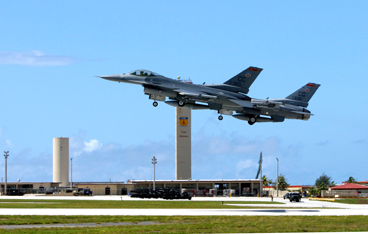 |
Two F-16 fighters go wheels-up for aerial intercept training at Andersen. (USAF photo by SMSgt. Mahmoud Rasouliyan) |
The impetus for the move initially came from the Japanese government, which wanted to ease the friction between Americans and Japanese on Okinawa. It was resisted by the Marine Corps, which argued that this political decision was militarily unsound. Over time, however, Marine Corps leaders found that training sites in Guam and its neighboring islands were more than adequate and their resistance lessened.
Moreover, the Marine Corps came to realize that they would have freedom of action on Guam because the political restrictions under which they operated in Japan would evaporate.
Guam is US territory, as are the other islands in the Northern Marianas, and thus the marines can come and go without notifying the Japanese government, which might or might not be receptive to the policies of whatever Administration is in office in Washington then. Indeed, after 2015, the US could even pick up marines on Okinawa, bring them to Guam, and then dispatch them wherever in the world they have been ordered, without consulting Japan.
In the neighboring Commonwealth of the Northern Marianas north of Guam, the Marine Corps foresees joint use of Rota and Saipan for aviation landing practice, and Farallon de Medinilla, Anatahan, and Sarigan for both live and inert ordnance targets. Tinian and Pagan would be sites for amphibious assaults, maneuvers, and artillery live fire training.
Getting agreements with the government of Guam, which has been mostly supportive of the military expansion because it will bring in jobs and a boost to the economy, will be more complicated. The Marine Corps is working on what it calls a “contiguous base concept” in which family housing, work places, and individual training sites are within easy reach of one another.
At the same time, the military staff say they want to see military people absorbed into the culture of Guam. “We don’t want a fence between us,” says a marine official. “We want to be neighbors.”
The arrival of roughly 17,000 people will put pressure on medical facilities, schools, child care, and other social services. In particular, the infrastructure needs a thorough overhaul, as the electrical grid, solid and liquid waste disposal, and the transportation system are not in good shape.
An initial estimate says it will take $10.3 billion to refurbish the infrastructure.
All this must be accomplished, Marine Corps officers said, while they mitigate the effects on the environment and find ways to prevent friction between their forces and the civilian community in Guam when everyone is living and working in close order on a tight little island.
Richard Halloran, formerly with the New York Times as a foreign correspondent in Asia and as a military correspondent in Washington, D.C., is a freelance writer based in Honolulu. His most recent article, “The New Line in the Pacific,” appeared in the December 2007 issue.